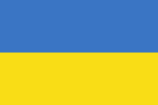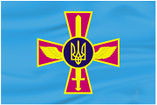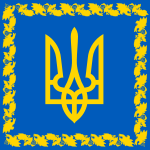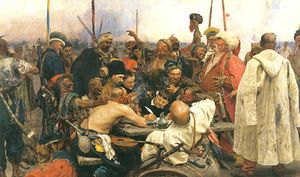Flag of Ukraine
 |
|
| Use | National flag and civil and state ensign |
|---|---|
| Proportion | 2:3 |
| Adopted | January 28, 1992 (originally in 1918) |
| Design | A blue and yellow bicolor. |
.svg.png) |
|
| Variant flag of Ukraine | |
| Use | Naval ensign |
| Proportion | 2:3 |
| Adopted | January 28, 1992. Dates back to 1918 |
| Design | White with a blue cotized cross that extends to the edges of the flag, and with the national bi-color in the canton. |
 |
|
| Variant flag of Ukraine | |
| Name | Ground force ensign |
| Design | Raspberry color field with Ground Forces logo in the center. |
 |
|
| Variant flag of Ukraine | |
| Name | Air force ensign |
| Proportion | 2:3 |
| Design | Blue field with Air Force logo in the center. |
.svg.png) |
|
| Variant flag of Ukraine | |
| Name | Sea Guard ensign |
| Proportion | 2:3 |
| Design | Green cross with a miniature Ukrainian flag in the upper left corner. |
The Flag of Ukraine (Ukrainian: державний прапор України; translit.: derzhavnyy prapor Ukrayiny; literally ‘state flag of Ukraine’) is the national flag of Ukraine. The national flag was officially adopted for the first time in 1918 by a short-lived Ukrainian People's Republic. At that time the commonly used yellow–blue flag had already turned into blue and yellow and sported a trident (tryzub) in the upper left corner. The insignia remained unchanged by the successive government of Pavlo Skoropadsky, and then by the Directorate of Ukraine. During the Soviet era, Bolsheviks had been using red and later red-blue flags as the official Flag of Ukrainian SSR. The blue and yellow flag was officially restored in 1992 following Ukrainian independence.
Article 20 of the Constitution of Ukraine states “the State Flag of Ukraine is a banner of two equally sized horizontal bands of blue and yellow colour.”
Ukraine celebrates Flag Day each year on August 23.
Contents |
History
The color blue of the Ukrainian Flag represents the color of the sky, and yellow symbolizes the lush golden wheat fields of this country. These two colors, blue and yellow, have been associated with Ukraine from the times before the introduction of Christianity. Now they are incorporated into the flag of Ukraine.
However, Ukrainians commonly refer to the flag as yellow and blue (Zovto-Blakitnij) - a different version of the flag used during UNR (Ukrainian National Republic) years (1917-1921). With yellow on the top and blue on the bottom. Yellow on the top represents golden roofs (Kupola) of Christian churches and blue - river Dniper.
The roots of Ukrainian national symbols come from before Christian times when yellow and blue prevailed in traditional ceremonies, reflecting fire and water.[1]
In Kievan Rus' times, yellow and blue continued to be popular. These colours were used on the banners of the Halych-Volhynia principality in the 13th–14th centuries.
Yellow–blue, red-black, crimson-olive and especially raspberry color banners were widely used by Cossacks between 16–18th centuries. These were not the only possible combinations, since normally Cossacks would fly their hetman's banners, which were similar to the coats of arms of the nobility. Also, yellow and blue were the colours common on coats of arms in Galicia. In fact, the coat of arms of Lviv to this day remains a golden lion on a blue field.
Some put the starting point of the current national flag of Ukraine in year 1848, when during the Spring of the Nations a yellow and blue banner flew over the Lviv magistrate for the first time. Although this move didn't have significant consequences, the newly formed Ukrainian divisions in the Austrian army used yellow and blue banners in their insignia.
It has to be noted that although most Ukrainians identify their flag in the verbal language as "yellow and light blue" (Ukrainian: жовто-блакитний, zhovto-blakytnyy), the current flag in reality is blue (the top string) and yellow (the bottom string). The issue is quite notable, because the historical rotation of the flag (from yellow–blue to blue–yellow) did not affect the spoken language. Back in 1848 the flag was indeed yellow and blue, and it was later rotated to blue and yellow to be appealing to a common person. The common explanation of "blue sky above yellow field of wheat" was invented around that time, and, although it has nothing to do with the choice of colours and the history of the original yellow and blue banner, it certainly formed the flag as we know it today.
In the late 19th century, the Austro-Hungarian Empire was much more tolerant toward the Ukrainian national movement than the Russian Empire. A lot of literary work was done there, thus spreading the idea to the rest of Ukraine.
Short independence: 1917–1920
| Flags of Ukraine across time |
|---|
 Halych-Volhynia |
 Cossack Hetmanate |
 Ukrainian People's Republic (1917–1918)[2] |
 Ukrainian People's Republic (naval flag; 1917–1921) |
 West Ukrainian National Republic (1918–1919) |
 Free Territory (1918–1921) |
.svg.png) Ukrainian SSR (1919–1929). |
.svg.png) Ukrainian SSR (1929–1937). |
.svg.png) Ukrainian SSR (1937–1949). |
 Ukrainian SSR (1949-1992) |
 Modern Ukraine (since 1992) |
Both blue–yellow and yellow–blue flags were widely used during the Ukrainian struggle for independence in 1917-1920.
At present, there are no reliable sources that indicate that an official flag was declared by the Ukrainian People's Republic in 1917-1918. Some sources mention that the yellow–blue was adopted by Tsentralna Rada on March 29, 1918[3] Other sources point out that no hard proof of such decision exists.[4] Instead, they refer to the decision on the Fleet Flag, which was set to be light blue–yellow[5] as an indication that the official flag was light blue–yellow.[6]
The official flag of Pavlo Skoropadsky's Hetmanate was blue–yellow and became light blue–yellow under Semen Petlura's Directorate. The flag of West Ukrainian National Republic was blue and yellow but changed over time. The anarchist free-soviets that existed during the civil war used the black flag.
Among Ukrainian immigrant organizations there were proponents of both blue–yellow and yellow–blue flags. Eventually, it was agreed to use the light blue–yellow flag until the issue was resolved in the independent Ukraine.
Soviet Ukraine: 1922-1993
The Soviet Ukraine similarly to other Soviet republics, used a red flag with golden abbreviation "УСРР" or "УРСР" (Ukrainian Socialist Soviet Republic, or Ukrainian Soviet Socialist Republic from 1936) in the top left corner. In 1937 hammer and sickle symbol in gold was added to the flag.
Postwar Ukraine
In 1947 Soviet republics, including Ukraine, adopted new flags instead of previous featureless ones. The new Ukrainian flag consisted of a red (top, 2/3) and a blue (bottom, 1/3) stripes, with golden star, hammer and sickle in the top left corner.
Return of the national flag
Under the influence of Mikhail Gorbachev's Perestroika and Glasnost years, the individual Soviet republics had strengthened their sense of national unity, which led to the Collapse of the Soviet Union in 1991. This concerned the three Baltic states and Western Ukraine, which were the last territories annexed into Soviet Union. These efforts were accompanied with attempts to restore the respective historical national symbols. In 1988, the Supreme Soviet of the Lithuanian SSR re-established Lithuania's historic coat of arms as the state symbol. The Parliaments of Latvia and Estonia soon followed.
The events in the Baltic countries soon led to similar processes in Ukraine. Particularly, West Ukraine and Ukrainian SSR's capital Kiev (Kyiv) constantly held political demonstrations with the national yellow-and-blue flags waving above the heads of demonstrators.
- On March 20, 1990, the town council of Ternopil voted upon the usage and re-establishment of the yellow-and-blue flag and the tryzub as well as the national anthem Shche ne vmerla Ukrainy. On the same day, the yellow-and-blue national flag was flown for the first time in about 80 years on a governmental building in Kiev, replacing the then official red-and-blue flag of the Ukrainian SSR.
- On April 28, 1990, the oblast council (oblasna rada) of Lviv also allowed the use of the national symbols of Ukraine within the Oblast.
- On April 29, 1990, the yellow-and-blue flag was flown from the Ternopil city theater's flagstaff without the official flag of the Soviet Union hanging above it.
- After July 24, 1990, the yellow-and-blue flag was flown for the first time over an official governmental building of the Kiev City Council on the Maidan Nezalezhnosti square of the Khreschatyk street.
- After the declaration of independence of Ukraine on August 24, 1991, the national yellow-and-blue flag flew for the first time over the Ukrainian Parliament (Verkhovna Rada) building on September 4, 1991.
 Flag of Ukraine - Presidential standard. |
.svg.png) The 2:3 ratio of the flag of Ukraine. |
 Flag of Ukraine |
|
 Yellow–blue and red-black Cossack flags at Reply of the Zaporozhian Cossacks painting by Ilya Repin, 1880-1891. |
 Yellow–blue flag at Ukrainian People's Republic Poster, B.Shippikh, Kiev, 1917. |
 The Ukrainian flag flying on Maidan Nezalezhnosti. |
Colors
The Law of Ukraine states that the colors of Ukrainian flag are "blue and yellow", being silent on the specifics of the blue and yellow colors. Heraldic communities attempt to fill the gap and specify the "true" colors of the flag. In the table below the colors are given according to amateurs site vexilla-mundi.com:
| Scheme | Dark blue | Yellow |
|---|---|---|
| Pantone | 286 C | 108 C |
| RGB | 0-0-205 | 249-221-22 |
Legal status
Article 20 of the Constitution of Ukraine states the following, citing: "the State Flag of Ukraine is a banner of two equally sized horizontal bands of blue and yellow color." (ukr: "Державний Прапор України є банер з двох однакових за розміром горизонтальних смуг синього і жовтого кольору." [7]).
See also
- List of flags of Ukraine
- Coat of arms of Ukraine
- Flag of Crimea
- Flag of Dalmatia
- Flag of Saint-Ghislain
- Flag of Herve
- Flag of Barbados
References
- ↑ Geraldika.ru Флаг Украины
- ↑ Abbott, Peter; Eugene Pinak; Oleksiy Rudenko (2004). Ukrainian Armies 1914-55. Osprey Publishing. pp. 9, 13. ISBN 9781841766683.
- ↑ State Symbols of Ukraine, Cabinet of Ministers of Ukraine, website.
- ↑ http://vexillography.narod.ru/ukraine/unr.htm
- ↑ Ukrainian Historical Journal, 1999, #4, ISSN 0130-S247
- ↑ Українське військо у ХХ-ХХІ сторіччі
- ↑ Constitution of Ukraine
External links
- Ukraine at Flags of the World
|
|||||||||||||||
|
|||||||||||||||||||||||||||||
|
|||||||||||||||||
|
||||||||
